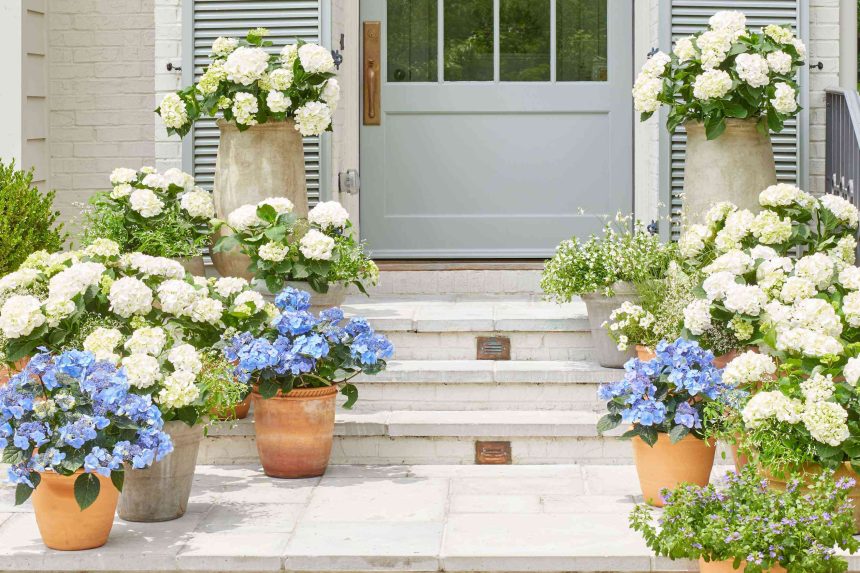Whether you’re a novice gardener or house plant parent or have been gardening wisdom on your side, there comes a time when you’ll need to provide your plants with a new home—a bigger pot. You’ll likely keep the container to reuse for other gardening needs, such as to start seeds or have a backup for other plants that will eventually need more spacious digs.
But it may not even cross your mind, that gardening containers should be cleaned before repotting. It’s soil, after all, right? Yet, it’s a good idea to clean your ceramic or plastic pots to minimize pests and pathogens. Diseases can get passed on in the soil which can affect your new or repotted plants from thriving. “It is important to clean pots or containers before planting new plants or reusing the same pot,” says Amy Hovis. “Cleaning the pots helps prevent the spread of pests, diseases, or pathogens that may have accumulated on the surfaces.”
Why Clean A Pot Before Planting?
When growing indoor or outdoor plants, you want to give them the best environment to grow and thrive. After all, you’re investing time and money so you might as well take an extra step to ensure better outcomes. “Since prevention is the best cure, a clean, sterile pot and fresh bagged soil is the best way to start out,” says Parker Andes. There’s always a risk that bacteria or pathogens are in the pot and reusing it without disinfecting first could potentially spread to your new plants. “Non-beneficial fungi and viruses, fungus gnats, even bacteria that cause root galls are all nature’s way of keeping populations in check—of course, we don’t want that to apply to our plants,” says Andes.
Does The Material Of The Container Make A Difference?
The type of material of your pot will influence what cleaning products you can use. If you have a steel or iron-coated pot, you’ll want to stay away from bleach. “Do not use bleach on a galvanized container, it will corrode it,” says Andes. Some materials may take longer to clean due to how they are made. “Ceramic and terracotta pots are more porous than plastic—it just takes longer to clean them up,” he says.
How To Clean And Disinfect Gardening Containers
Cleaning your pots is simple and easy. Hovis recommends using a common pantry staple to clean containers. “You can use a vinegar solution by mixing equal parts of water and white vinegar [and] submerge the pot in the solution and let it soak for about 10 minutes,” she says. “After soaking, you can scrub the pot with a brush or sponge to remove any remaining dirt or stains.” Make sure to thoroughly rinse the containers to ensure there aren’t any traces of the cleaning solution. You also want to wait until it’s completely dry before using the pot, she says. “Make sure there is no moisture left, as it can promote the growth of fungi or bacteria.”
Hovis doesn’t recommend bleach. But in certain situations, Andes suggests a bleach solution. “If you’re growing a hobby greenhouse of orchids or you’re starting your garden’s seedlings in last year’s plastic tray with the clear cover then you should wash each pot, followed by disinfecting with a bleach solution [of] one part bleach to 9 parts water,” says Andes. But if you’re only cleaning a few pots, he suggests skipping the bleach and using a disinfectant wipe instead.
He shares his method when it’s only a few containers, “Hose them off, brush off any stuck-on soil, and hose again and let dry, then wipe with a disinfecting wipe.”
What To Do If You’ve Reused Dirty Containers
If you’ve recently potted plants in unwashed containers, don’t freak out! There are some situations when it’s more important that a container has been cleaned. For example, sowing seeds in disinfected containers will give you a better chance for success since it’s a sensitive and crucial time. If you’re wondering what can happen if you reuse a garden pot without cleaning it first, Andes says, “Unless you’re starting seeds or reusing a pot that contained a diseased plant, probably nothing.”
And there are times when, even experts admit to not doing a thorough cleaning before repotting, based on the hardiness of the plant. “Now to be honest, if I was repotting a tough-to-kill snake plant (Sansevieria) or an overgrown Jade plant, I would probably brush the dirt off the new planter, wipe it down with a rag [and] then plant using fresh potting soil and not think about it again,” says Andes.







